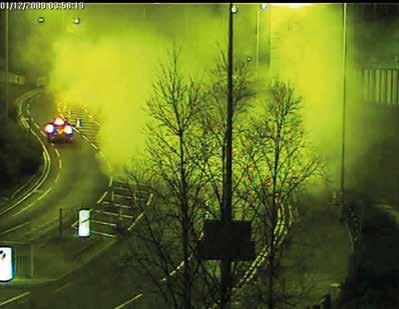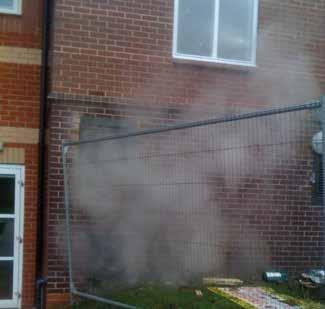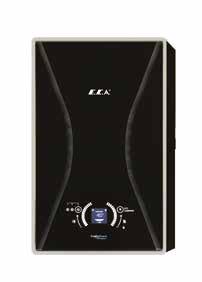
6 minute read
Technical
Fan-diluted flue systems
Fan-diluted flue systems may be used to disperse products of combustion in high-rise buildings. Here, Barrie Church looks at some of the questions he receives on proving air flow at the correct rate when flow volumes are variable.
In recent weeks, I have received several queries regarding the safety of interlocks on fan-diluted flue (FDF) systems using variablespeed drives (VSDs) on multiple boiler installations. FDF systems are used when it is impossible to get the chimney to high level, for example, in a high-rise apartment block. They dilute the products of combustion to a safe level that does not cause low-level environmental issues.
Without the correct suction conditions under all boiler loads and necessary air-flow interlocks, the system can be dangerous because products of combustion will not be drawn away from the boiler chimney/flue.
Unstable combustion
There are many problems with using VSD control with fan-diluted flue systems. The main issue is that the design must maintain the correct ‘range’ of suction conditions on the primary flue header, just as it is required of a chimney. These conditions must be interlocked with the operation of the appliances. This means that the first thing to do is find out from the appliance manufacturer the end points of these conditions. Too much or too little can lead to unsafe or unstable combustion.
Unfortunately, many appliance manufacturers are unable to provide this information and you may need to rely on the experience of the fan-diluted flue designer, or, better still, go to a manufacturer that can provide the information.
It’s vital to ensure that there is as much draught control as necessary in the appliance connections, which depends on the space available as well as knowledge of the appliances.
Under some wind conditions, the interlocks may prove OK without the fan running, which illustrates that you should always prove that the fan is running. IGEM/UP/10 – Installation of flued gas appliances in industrial and commercial premises – refers to using a no-volt interlock on the three-phase motor starter.
The inlet air system can be blocked by all manner of things, from crisp packets to snow and leaves – and even sheets of hardboard. The fact that the suction conditions have been met does not always mean that there is a flow. Paddle flow switches can be unreliable and, at very low boiler demand, might not be good enough to ensure safety.
3Differential pressure switches across attenuators or inlet grilles or fans could be applied. But even with the correct interlocks in place, nothing beats good regular maintenance to ensure safety.
A detailed analysis must be performed on the necessary interlocks and failure modes to guarantee safety under all boiler operating conditions.
3A differential pressure switch monitoring negative pressure on the inlet side of the fan is best policy, with the motor speed inverter monitoring motor operation as well.
3All FDF systems require proper commissioning and maintenance by those who understand the design of the system. Adding fixed balancing dampers in various parts of the ductwork is essential, with all dampers having at least 25 per cent cutaway openings and rigidly locked into position.
3It is recommended that dampers are incorporated in each boiler connection, which are usually of the lockable quadrant type. However, the inlet damper is not usually of a balancing type and is generally left fully open. In most cases, it would be better if this inlet damper is installed between the boilers and the fan so that it can be used for balancing the system against the fan duty.
6Some designers have used the FDF system to extract air from the boiler room via a motorised damper and room stat. This is potentially very dangerous because the suction in the boiler room will increase as the boiler load increases. It could affect the air flow into the burner and, depending upon the types of balancing dampers that are fitted, affect the flue gas passage to the exhaust grille.
IGEM/UP/10 advises against fan extract systems unless there are inlet fans to balance the extract. In my view, it’s
A typical fan-diluted flue system with external variable-speed drive


Condensing systems operating with fan-diluted flues can cause serious environmental and safety problems
best to have separate systems, even if both are
VSD-controlled. Where dilution air is extracted from the plant room, the ventilation must be increased substantially if it is by natural means, such as louvres, because it has to be based on at least 2.0m/sec jet (1.0m/sec face) velocity.
Where the ventilation is mechanical, the supply must be interlocked and able to provide enough to cover both the dilution air requirement and combustion air.
Condensate
The last point that I would like to make relates to condensate. The design information in the standards relates to noncondensing boilers: however, the air flow and temperature conditions for the design need to be dramatically changed for condensing boiler systems, whose waste gases can be like a fog when used with FDFs.
Vertical plumes have caused numerous 999 calls and horizontal plumes across highways have the potential to cause serious accidents.
The plume may not be a problem if the outlet is in an inconspicuous location, but it can be mitigated by entraining more dilution air so that the flue gas becomes unsaturated. However, this can increase the size and cost of the system substantially.
Other issues
• Corrosion issues with the use of the proper grade of stainless steel for system
longevity are often overlooked on grounds of cost. • The handling and removal of the condensate is also a big problem, and this may get worse as the concentration of hydrogen in natural gas increases. • Large damp stains on exterior walls by grilles are not acceptable – choose a better type of drip-free joint. • Condensate and dust will collect on the linings of the duct system and especially on the fan assemblies. This means that maintenance access is even more important than with non-condensing systems.
Speed control
• As a rough guide, it is only possible to reduce the fan
motor to around half speed as a minimum, as the differential pressure switch will be at the point of dropping out in this scenario, so this does limit the scope for variation. • Where different speed set points are configured to match selected boiler loads, it may be necessary to include multiple differential pressure switches, each monitoring the different boiler load configurations.
However, this depends on the
BMS and its flexibility. Barrie Church is past chairman of IGEM/UP/10* and consultant to Global Energy Associates. Thanks also to AI Flues for its assistance with this article.
*IGEM/UP/10 – Installation of flued gas appliances in industrial and commercial premises
Stay up to date with your app
In these fast-moving times, your Registered Gas Engineer app can help you stay up to date with all the latest news, wherever you are. We’ve made important updates to your FREE app. So please make sure you choose ‘Update’ at your app store to unlock some great new features.
Stay up to date – choose Latest News Feeds to see the latest news from Gas Safe Register and around the industry PLUS the newest products and jobs. Simply tap on the headline and the full article opens in simple, readable text. Find the latest technical articles, news and features, Technical Bulletins, Industry Standard Updates and Safety Alerts. Choose e-Journal replica to download and read 12 full magazine editions on your mobile device.
*Available to Gas Safe registered engineers only. You’ll need to log in with your Gas Safe registration number for verification the first time you use the app.












